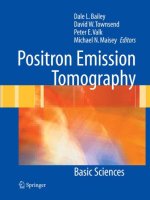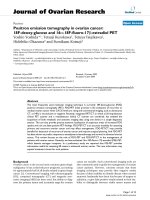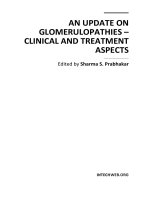POSITRON EMISSION TOMOGRAPHY – CURRENT CLINICAL AND RESEARCH ASPECTS pdf
Bạn đang xem bản rút gọn của tài liệu. Xem và tải ngay bản đầy đủ của tài liệu tại đây (15.42 MB, 346 trang )
POSITRON EMISSION
TOMOGRAPHY –
CURRENT CLINICAL AND
RESEARCH ASPECTS
Edited by Chia-Hung Hsieh
Positron Emission Tomography – Current Clinical and Research Aspects
Edited by Chia-Hung Hsieh
Published by InTech
Janeza Trdine 9, 51000 Rijeka, Croatia
Copyright © 2012 InTech
All chapters are Open Access distributed under the Creative Commons Attribution 3.0
license, which allows users to download, copy and build upon published articles even for
commercial purposes, as long as the author and publisher are properly credited, which
ensures maximum dissemination and a wider impact of our publications. After this work
has been published by InTech, authors have the right to republish it, in whole or part, in
any publication of which they are the author, and to make other personal use of the
work. Any republication, referencing or personal use of the work must explicitly identify
the original source.
As for readers, this license allows users to download, copy and build upon published
chapters even for commercial purposes, as long as the author and publisher are properly
credited, which ensures maximum dissemination and a wider impact of our publications.
Notice
Statements and opinions expressed in the chapters are these of the individual contributors
and not necessarily those of the editors or publisher. No responsibility is accepted for the
accuracy of information contained in the published chapters. The publisher assumes no
responsibility for any damage or injury to persons or property arising out of the use of any
materials, instructions, methods or ideas contained in the book.
Publishing Process Manager Martina Durovic
Technical Editor Teodora Smiljanic
Cover Designer InTech Design Team
First published February, 2012
Printed in Croatia
A free online edition of this book is available at www.intechopen.com
Additional hard copies can be obtained from
Positron Emission Tomography – Current Clinical and Research Aspects,
Edited by Chia-Hung Hsieh
p. cm.
ISBN 978-953-307-824-3
Contents
Preface IX
Part 1 Imaging Processing, Kinetic Modeling and Software 1
Chapter 1 Virtual PET Scanner – From Simulation in GATE
to a Final Multiring Albira PET/SPECT/CT Camera 3
M. Balcerzyk, L. Caballero, C. Correcher,
A. Gonzalez, C. Vazquez, J.L. Rubio, G. Kontaxakis,
M.A. Pozo and J.M. Benlloch
Chapter 2 Rationale, Instrumental Accuracy,
and Challenges of PET Quantification for Tumor
Segmentation in Radiation Treatment Planning 27
Assen S. Kirov, C. Ross Schmidtlein, Hyejoo Kang and Nancy Lee
Chapter 3 Kinetic Modelling in Human Brain Imaging 55
Natalie Nelissen, James Warwick and Patrick Dupont
Chapter 4 Free Software for PET Imaging 85
Roberto de la Prieta
Part 2 Radiopharmaceuticals 113
Chapter 5 Pd
0
–Mediated Rapid C–[
11
C]Methylation and
C–[
18
F]Fluoromethylation: Revolutionary
Advanced Methods for General Incorporation
of Short–Lived Positron–Emitting
11
C and
18
F Radionuclides in an Organic Framework 115
Masaaki Suzuki, Hiroko Koyama,
Misato Takashima-Hirano and Hisashi Doi
Chapter 6 Emerging Technologies for
Decentralized Production of PET Tracers 153
Pei Yuin Keng, Melissa Esterby and R. Michael van Dam
VI Contents
Chapter 7 Specific Activity of
11
C-Labelled Radiotracers:
A Big Challenge for PET Chemists 183
Vanessa Gómez-Vallejo, Vijay Gaja,
Jacek Koziorowski and Jordi Llop
Part 3 Clinical Application and Diagnosis 211
Chapter 8 Potential of Positron Emission Tomography
for Neurogenic Tumors and Spinal Disorders 213
Kenichiro Kakutani, Koichiro Maeno, Yuki Iwama,
Masahiro Kurosaka and Kotaro Nishida
Chapter 9 [
18
F]Fluorodeoxyglucose Positron
Emission Tomography in Alzheimer
Disease and Related Disorders 225
Nobuhiko Miyazawa and Toyoaki Shinohara
Chapter 10 Amyloid Imaging PET Ligands as Biomarkers
for Alzheimer’s Disease, Preclinical Evaluation 255
Marie Svedberg, Ewa Hellström-Lindahl,
Obaidur Rahman and Håkan Hall
Chapter 11 Monitoring of Chemotherapy
Response in Malignant Pleural Mesothelioma 275
Tatsuo Kimura, Shinzoh Kudoh and Kazuto Hirata
Chapter 12 Tumour Markers and Molecular Imaging with
FDG PET/CT in Breast Cancer: Their Combination
for Improving the Prediction of Disease Relapse 291
Laura Evangelista, Zora Baretta, Lorenzo Vinante,
Guido Sotti and Pier Carlo Muzzio
Chapter 13 Glucose Uptake During Exercise in Skeletal Muscles
Evaluated by Positron Emission Tomography 319
Hiroyuki Shimada
Preface
Positron emission tomography (PET) is a molecular imaging technology for examining
the molecular basis of normal biological functions of cells and their failure from
diseases. By using radio-labelled tracers, four-dimensional (4D) images can be
reconstructed by a computer. This computer shows the concentration and location of
the tracer of interest, and noninvasively observes the changes of interesting molecular
targets in living subjects. Therefore, PET plays a critical role in the era of molecular
medicine because it allows for earlier diagnosis and better management of patients
with various diseases, such as cancer, neurodegenerative diseases, mental diseases,
and metabolic disorders.
This book’s stated purpose is to provide a discussion of the technical basis and clinical
applications of PET, as well as their recent progress in nuclear medicine. It also
summarizes current literature about research and clinical science in PET. The book is
intended not only for scientists, but also clinicians seeking recent information
regarding PET imaging processing, kinetic modelling, free software,
radiopharmaceuticals, clinical application, and diagnosis. The authors are qualified
experts in the fields of physics, chemistry, technology, and medicine. They introduce
each concept clearly, and they provide new research data and valuable experiences in
their respective areas. We hope that both clinicians and scientists find this work useful
and stimulating.
Finally, I would like to acknowledge the contributions of the authors and the team of
the Publishing Process Management at InTech - Open Access Publisher. Additionally, I
would like to thank Ms. Jean Hung and Dr. Chi-Wei Chang for review assistance.
Dr. Chia-Hung Hsieh, PhD
Associate Professor,
China Medical University and Hospital,
Taiwan
Part 1
Imaging Processing,
Kinetic Modeling and Software
1
Virtual PET Scanner – From Simulation
in GATE to a Final Multiring Albira
PET/SPECT/CT Camera
M. Balcerzyk
1,5
, L. Caballero
3
, C. Correcher
3
,
A. Gonzalez
2,3
, C. Vazquez
4
, J.L. Rubio
4
, G. Kontaxakis
4
,
M.A. Pozo
5
and J.M. Benlloch
2
1
National Accelerators Center, University of Seville
2
I3M, CSIC, Valencia
3
Oncovision, Valencia
4
Technical University of Madrid
5
Complutense University of Madrid
Spain
1. Introduction
Simulation of the Positron Emission Tomography (PET) camera became a useful tool at the
level of scanner design. One of the most versatile methods with several packages available is
Monte-Carlo method, reviewed in (Rogers 2006). It was applied in GEANT4 code
(Agostinelli et al. 2003) used in nuclear physics applications. Other codes used in medical
physics and medicine are EGS (for review see (Rogers 2006)), FLUKA (Andersen et al. 2005),
MCNP (Forster et al. 2004), PENELOPE (Sempau et al. 2001).
The simulations of PET scanners are done in GATE software (Jan et al. 2004) which
extensively uses GEANT4. This versatile package offers the possibility of simulation of
radioactive source decays. It allows tracking of the individual γ events resulting after
positron-electron annihilation. They can be absorbed by photoelectric event in the detector
crystal or scattered in the phantom. It allows also simulation of detector electronics
including paralyzed mode of the amplifiers. Coincidences can be monitored if they are true
or random. The software is now available in version 6.1. Part of the simulations were
performed in version 3.0, part in vGate 1.0 (containing version 6.0 via virtualization
software for Linux).
GATE was used in simulation of SPECT and CT systems (see papers citing (Jan et al. 2004)).
Among PET systems for example Siemens PET/CT Biograph 6 scanner (Gonias et al. 2007),
GE Advance/Discovery LS (Schmidtlein et al. 2006), Philips Gemini/Allegro (Lamare et al.
2006), Philips Mosaic small animal PET (Merheb, Petegnief and Talbot 2007) or purely in-
silicon (van der Laan et al. 2007) were used for simulation or design of new detectors and
systems.
Positron Emission Tomography – Current Clinical and Research Aspects
4
After the initial electronic designs of the camera, its geometry and number of detectors,
one can successfully simulate the data collection process including a wide variety of
radioactive sources. Data can be classified to individual interactions in the detector
(photoelectrically absorbed, scattered), at the coincidence level (true coincidences,
scattered coincidences or random coincidences). Singles and coincidences are processed in
digitizer module which simulates event collection from initial gamma absorption, via
photon generation and reflection within the crystal (not implemented in current
simulation), electronic pulse formation, amplification with dead times of the amplifiers,
forming of singles and coincidences and then reconstructed into an image of the measured
source.
We started from simulating an existing PET scanner called Albira with one ring formed by
eight detectors and compared with actual measurements of point sources, animal NEMA
phantoms and source grids. As the simulations reproduced very well the actual data in
terms of coincidence and single rates, and also in terms of image quality, we moved forward
to two and three rings scanner composition, which were at this time only in the design
phase. As the electronic modules were to be the same it was a perfect case for simulation.
In the development of new electronics, the depth of interaction was to be included and, this
implementation was also simulated in GATE prior to preparation of electronics. This data
allow us to observe how the image quality is influenced by the particular implementation of
such correction.
On the base of PET camera design and simulation, the multiring version of a breast PET
tomograph (MAMMI) was also introduced into the simulation. Again, the simulated data
were the base of design modifications and allowed to prepare a reconstruction software long
before first real data were taken with a prototype.
2. Methods
We thoroughly modified the simulation of 1-ring Albira scanner prepared by Aurora
Gonzalez for her Master thesis on the base of the benchmark of a PET scanner simulation
included in Gate release (Gonzalez 2008).
Generally, the simulation of the PET scanner contains the following modules and
submodules:
1. Main module, containing calls to submodules.
2. Visualization module, which defines the way the simulation, is presented during run.
3. Camera module, which defines tomograph size, crystal dimensions and grouping.
4. Phantom module, which defines phantom inserted in the scanner. The phantom can be a
geometrical structure or a pixelated phantom, based on 3D image.
5. Physics module, which defines the processes to be included in the simulation.
6. Digitizer module, which defines how the γ particle detection is processed. It can be
very detailed, i.e. storing information on individual interactions in stopping process,
then how photons of the scintillation process are reflected in the crystal, how they are
detected by the photomultiplier. Then the amplification stage is simulated with
energy windows, dead times of the amplifiers, if they are paralysable or not, etc. This
Virtual PET Scanner –
From Simulation in GATE to a Final Multiring Albira PET/SPECT/CT Camera
5
leads to detection of a single event, which can also be stored, and then processed in
several coincidence processors, with individual energy (or signal height) windows,
and delays.
7. Sources module, which defines sources in geometrical or point form. Sources may be also
masked with the phantoms, which allow more complicated geometries, like Derenzo
phantom, animal pixelated phantoms, etc.
The listing of the Gate macro with corresponding submodules is provided in Appendix 1
(Section
9.1) of this chapter. The macro is based on benchmarkPET.mac macro provided
with Gate 3.0.0. Additional materials used in Gate (in a form readable by Gate) are provided
in Appendix 2 (Section
9.2). The file used in Root program (bundled with Gate) to calculate
ist mode files and statistics can be obtained from the corresponding author (MB, see
Appendix 3, Section 10.3)). This program is based on benchmarkPET.C provided with Gate
3.0.0.
The Albira camera mounts one to three rings formed by eight detectors, each containing
only one single crystal fit to a position sensitive photomultiplier (PSPMT). One can see the
details in Fig.1, Fig.2 and Fig.7. Such large crystal coupled to the PSPMT allows one to
additionally detect the depth of interaction of the annihilation gamma ray in the crystal
(Lerche et al. 2005; Lerche 2006). The position detection resolution in this continuous crystals
are 1.9±0.1 mm in plane of the PSPMT (i.e. axial and tangential directions), and about
3.9±1.5 mm in depth direction (i.e. radial). The errors of these values resulted from variation
of these values in the crystal space. The largest errors appear in the edges and corners
whereas and smallest errors are located in the center of the crystal, as expected.
General characteristics of the simulated Albira camera are as follows:
8 tapered center-pointing trapezoid crystals of 9.8 mm thickness (1-ring scanner), or
12 mm thickness (2- and 3-ring scanner).
Albira crystals are made of LYSO (Lu
0.95
Y
0.05
)
2
SiO
5
:Ce
The process and stored area of each detector is 40×40 mm.
Dead time for singles is 0.4 µs paralysable and then 2 µs in non-paralysable mode, for
coincidences is 1.8 µs non-paralysable mode.
For simulations we used a mouse phantom and a point-like source at the center of the
FOV according to NEMA standard.
The separation of multiple rings is 4.4 mm. Crystal separation (bore) along the scanner
diameter is 112 mm.
For verification of the 1 ring simulation we placed the “real” mouse phantom in the
center of the FOV of the actual scanner and loaded the tube with 237 µCi of 18-FDG. For
a point source measurement, an eppendorf with a droplet of a few tens of µl (18-FDG)
was centered placed. The measurements were performed for about 16 hours to end up
at the activities of around 1µCi, as suggested also in NEMA standards.
Radioactivity of
176
Lu was not included in the simulations. In the crystals of Albira we
estimate the abundance of
176
Lu (2.59% naturally, 3.78×10
10
years half-life) to be
280Bq/ml (Moszynski et al. 2000).
The sketch of 2-ring scanner is shown in Fig.1
Positron Emission Tomography – Current Clinical and Research Aspects
6
Fig. 1. Sketch of the dimensions of 2-rings camera in a horizontal plane. All dimensions are
in mm. For 1-ring scanner the main difference is that the crystals are 9.8 mm thick, instead of
12 mm for 2- and 3-ring scanner. In simulations, 12 mm crystals were used, in actual
production they are of 10 mm.
3. Validation of simulation for a one-ring scanner with the measurement of
mouse phantom
We simulated six different activities for a mouse phantom, exactly the ones that were
measured with the phantom. A view of scanner with the mouse phantom and source during
the simulation is depicted in Fig.2.
Virtual PET Scanner –
From Simulation in GATE to a Final Multiring Albira PET/SPECT/CT Camera
7
Fig. 2. Simulated 1-ring Albira scanner at a cross section at x=0 plane. XYZ axes are coded as
x in red (not seen in the image), y in green and z in blue. The green cylinder in the image
represents the location of the tube with radioactive material. In the camera, green structures
refer to the crystals.
The simulations were initially done for 1 s acquisition, while the measurements were taken
in 10 s frames, and the values of singles and coincidences were counted with a customized
Albira application. The comparison between the simulated and acquired real data is shown
in Fig.3 and Table 1.
One can see from Fig.3, that coincidence rate is particularly well reproduced almost in the
whole activity range down to 1.5 µCi (-10% error) and reduces to about 20% below 1 Ci
levels Single rates are well reproduced down to 100 µCi, while below this activity the
correspondence is quite poor. We would not underestimate the discrepancies for low
activities, as this may be the source of artifacts in the images in animals in the areas of low
injected activity.
One possible explanation of the effect is the background activity of
176
Lu. The estimate gives
the rate of
176
Lu decay events of about 270 cps per ccm, which translates into about 45 kcps
in all detectors, and about 2700 cps in one detector at ±30% energy window (see background
spectrum of LSO:Ce in Figure 1 of (Moszynski et al. 2000). 1 ring Albira scanner has 33%
solid angle coverage (Balcerzyk et al. 2009). 0.92 µCi (32 kBq) source generates about 770
singles in a detector. If, as calculated,
176
Lu background is about 2700 cps in a single crystal,
we would simulate only about 770
770+2700
=22%
⁄
which corresponds well with 29%
shown in Fig.3.
Positron Emission Tomography – Current Clinical and Research Aspects
8
Fig. 3. Comparison between simulated and real coincidences and singles in the 1-ring Albira
scanner geometry. Diamonds show the ratio of simulated to real coincidences. Squares show
the analogous ratio but for singles. Coincidences are well reproduced (i.e. above 90%
agreement) down to 1.5 µCi, while singles agree well for activity values higher than about
50 µCi. Data labels indicate detailed values of these ratios.
Activity,
kBq
Measured
coincidences rate,
1 ring
Measured
singles rate,
1 ring
Simulated
coincidences rate,
1 ring
Simulated
singles rate,
1 ring
8769 30197 901229 26743 835574
7892 28866 845677
7015 27969 792326
6138 26603 728288
5261 24924 652691
4384 22577 575520
3507 20024 489651 18068 441574
2630 16700 392602
1753 12283 280864
877 6938 156013
438 3640 87008 3295 67749
263 2266 58374
175 1549 43782
88 799 29248
53 500 23526 431 8414
35 337 19878 267 5552
17 196 16525 141 2799
Table 1. Detailed comparison between single and coincidence rates for 1-ring scanner, used
to calculate the diagram in Fig.3 for a mouse phantom. Note that for activites below 1.5µCi
there is a slight discrepancy between simulated and registered singles.
98.68%
99.07%
97.72%
92.20%
85.19%
78.77%
97.00%
94.32%
81.49%
37.39%
29.24%
17.76%
0%
20%
40%
60%
80%
100%
120%
0.1 1 10 100 1000
activity, microCi
Simulted to real conincidences and singles
1 ring, mouse phantom, 30% window
Simult to real coninc
Simult to real singles
Virtual PET Scanner –
From Simulation in GATE to a Final Multiring Albira PET/SPECT/CT Camera
9
A 5 ns coincidence window should translate into about 1 to 2 cps in coincidences, which is
the measured rate in empty scanner. We see in Table 1 that for all very low activities there is
about 50 cps coincidence differences between measured and simulated ones. For the same
activities, the singles difference is about 15 kcps, which increases to about 70 kcps for high
activities. 15 kcps difference in singles treated as randoms yields about 2.3 cps in
coincidences (from R=2τS
2
relation, R being randoms, S singles rate, τ coincidence window
(Balcerzyk et al. 2009)).
With the above in mind, one can tell, that background activity of
176
Lu is rather not
responsible for discrepancy between simulation and experiment in coincidences but only for
singles. One possible reason may be the singles (and hence coincidences) discarded from the
tapered region of the crystals. In simulation, the distinction for the localization is very sharp,
as we do not simulate photon transport. In real measurement some of the signal from the
tapered area may probably leak into the detected area.
Background activity of
176
Lu is now used in Albira scanner for internal tests of detectors
upon initialization of the instrument.
Fig. 4. Efficiency for a mouse phantom simulated (filled symbol) in 1-ring camera compared
with measured data (open symbol).
0.0%
0.5%
1.0%
1.5%
0.1 1 10 100 1000
Efficiency
Activity of the mouse phantom, microCi
Efficiency,
30% Win Coinc,
7cm long mouse phantom
1 ring
Real 1 ring
Positron Emission Tomography – Current Clinical and Research Aspects
10
The efficiency for low activities stabilizes at about 0.9% regarding measurement and
simulates mouse phantom data. Those activities may serve as a reference for saturation and
dead time level calculations. For mouse phantom, an activity of 1 µCi may be taken as a
reference, especially for saturation estimations.
The simulation result of a cylindrical phantom for ∅10×10mm and 3.7 MBq 18F activity is
shown in Fig.5 for a cross section perpendicular to 1 ring scanner axis. One can see that true
scattered and random coincidences contribute little to the image quality, as their total level
is about 10% at NEC maximum. In Fig.6 one can see the contribution of each coincidence
type to NEC.
True coincidences
True un scattered coincidences
Scattered coincidences
Random coincidences
Fig. 5. Gate simulation of ∅10×10mm phantom with a solution of 3.7 MBq of
18
F in water
obtained with the 1 ring Albira scanner. Contribution of each type of coincidences is
described on the left and right margins. Gate simulated events were converted to four
separate list mode files and reconstructed in Albira reconstruction program.
Virtual PET Scanner –
From Simulation in GATE to a Final Multiring Albira PET/SPECT/CT Camera
11
Fig. 6. Simulated NEMA mouse phantom rates for true unscattered, true scattered, random
and total coincidences and noise equivalent counts (NEC) for 1 ring Albira scanner. Scatter
fraction is constant and about 9% for the whole activity range. NEC has its maximum at 8.8
MBq of the described mouse phantom.
4. Three- and two-ring scanner simulation
The 3D renders of the 2- and 3-ring scanner with the mouse phantom inside the camera are
shown in Fig.7.
Fig. 7. The cross section view at around x=0 of the simulated 2- and 3-ring scanner with the
mouse phantom inside. The coding of the colors is the same as in Fig.2, disregard extra
shapes inside the red mouse phantom.
0
5000
10000
15000
20000
25000
30000
35000
40000
0 100 200 300 400
Count rate, cps
Activity in phantom, microCi
Unscattered
Random
Scattered
Total
NEC
Positron Emission Tomography – Current Clinical and Research Aspects
12
Fig. 8. Efficiency in 30% energy window of coincidences for 1-, 2- and 3-ring scanner. Blue
shows 3-ring scanner, squares 2-rings and triangles 1-ring geometry. Open diamonds show
the efficiency for a 3-ring scanner with removed coincidences between 0
th
and 2
nd
ring
(border rings).
5. Efficiency
Fig.8 shows the efficiencies for coincidences for 30% energy window for 1-, 2- and 3-ring
scanner for simulations with closed symbols. 1-ring values are the same as in Fig.4. In this
picture one can see the power of a 3-ring scanner, where all coincidences are stored. With a
mouse phantom the efficiency reaches 5.3% for low activities. Assuming the proper
simulation of 1-ring camera, one can expect the same efficiency for a measured mouse
phantom, and for real animal measurements.
With open diamonds we show the efficiency in the projected 3-ring scanner with omission
of the coincidences between border rings 0
th
and 2
nd
. In one of the first projects, such design
was considered. It was estimated by analysis of first 50 coincidences from that scanner for
the pair of detectors which form the coincidence. Once can generate such ASCII output in a
table from Gate. The coincidences between rings 0
th
and 2
nd
include about 34% of all
detected coincidences. The line of response is at small angle towards z-axis of the scanner, so
one can expect large parallax errors for this pair of detectors. That effect suggested to
include the depth of interaction encoding, which was considered in the final version.
0.1%
1.0%
10.0%
0.1 1 10 100 1000
Efficiency
Activity of the mouse phantom, microCi
Efficiency,
30% Win Coinc,
7cm long mouse phantom
3 rings
Reduced at exclusion of
0thVS2nd ring coinc
2 rings
1 ring
Real 1 ring
Virtual PET Scanner –
From Simulation in GATE to a Final Multiring Albira PET/SPECT/CT Camera
13
5.1 Saturation level
Saturation levels for multiring scanners are shown in Fig.9. They heavily relay on the
choice of the two activities for which the efficiency is constant within 5%, being around
1µCi. However, some simulations there is higher efficiency at 0.5 µCi activity. The
difference may be due to fluctuations of small numbers, as the coincidence count for these
activities is around a few hundreds. In this only aspect 2-ring scanner is better than 1- and
3-ring scanner. The saturation of 50% for 1- and 3-ring scanner is at the level of about 120
µCi, while for 2-ring scanner it is about 320 µCi. We do not see the reason for 2-ring
scanner to behave so well in terms of saturation. It is possible that it is a geometrical effect
of having smaller fraction of the phantom within FOV of each ring in this geometry (see
Fig.7).
Fig. 9. Saturation levels for multiring scanners. For the 3-ring scanner with omitted 0
th
vs. 2
nd
ring coincidences, the saturation curve would be the same as for 3-ring geometry, as the
efficiency is calculated as a fraction of valid coincidences for all activities. As the number of
points for simulation is limited, we added the trend lines (2
nd
order polynomials) to look for
expected evolution at higher activities.
We drew also prediction lines using simple polynomial 2 curves level. The predictive value
of this curve is low, but it shows, that the expected 50% saturation level for 3-ring scanner is
higher than for 1-ring scanner.
0%
10%
20%
30%
40%
50%
60%
70%
0 100 200 300 400 500
Saturation level, %
Activity of the mouse phantom, microCi
Saturation level,
30% window of coinc, 7cm long mouse phantom
Real 1-ring
1-ring
2-ring
3-ring
Real 1-ring
prediction
1-ring prediction
2-ring prediction
3-ring prediction
Positron Emission Tomography – Current Clinical and Research Aspects
14
5.2 Omission of 0
th
vs 2
nd
ring coincidences in 3-ring scanner
The reader may have already found that we try to encourage the designers to drop the idea
of excluding 0
th
vs. 2
nd
ring coincidences. It would result in the loss of 34% of detected
coincidences. In Gate, there is no straightforward way to exclude the mentioned
coincidences from the simulation. The only way we perceive it, is to post-hoc exclude them
from simulated 3-ring scanner during the creation of list mode files. The problem is that
there will be false overestimation of saturation, dead times for coincidences and others
during the simulation, so the resulting list mode file will have an artificially lower
coincidence level.
6. Point source
The proper way (NEMA standard) to measure the efficiency is to place a point source of
activity corresponding to saturation level of less than 5% in the center of FOV. The
simulations were done for exactly 0.95 µCi source, which roughly fulfills the requirement
and the results are shown in Fig.10 in comparison with the real study in 1-ring scanner. The
real scanner measurement was done using a droplet of few tens of µl of about 10µCi of 18-
FDG placed in the eppendorf tube and at the center of FOV. For the 1-ring scanner the
measured value is 2.49%, while simulation returns 3.2% being in reasonable agreement with
expected 10% saturation level at 10 µCi. Again, one can see the superiority of 3-ring scanner
reaching 9.35% efficiency. This value may be further increased to about 12.9% if the tapered
areas of the crystal are used for the coincidence detection. This would require most likely
sophisticated point-spread function inclusion in the reconstruction besides other technical
challenges regarding position calibration of such impinging events.
Fig. 10. Efficiency for a real 1-ring scanner and simulated multiring scanners for the low
activity (0.95 µCi) point source placed in the center of FOV.
0%
1%
2%
3%
4%
5%
6%
7%
8%
9%
10%
Real 1-
ring
1 ring
9.8mm
cryst
2 ring s 3 ring s 3 ring s
without
0vs2
rings
Efficiency for 3 types of scanner
30% window, point source 0.95 Ci at the center of FOV
Real 1-ring
1 ring 9.8mm cryst
2 rings
3 rings
3 rings without 0vs2 rings
Virtual PET Scanner –
From Simulation in GATE to a Final Multiring Albira PET/SPECT/CT Camera
15
7. Depth of interaction
For the sources or phantom parts far radially from the center of the field of view, the
resolution is deteriorating, mainly due to the so-called parallax error. To correct it, if
possible, depth of interaction (DOI) of the detection of annihilation 511 keV γ photon needs
to be recorded, and not only planar coordinates in plane of the photomultiplier. In the
Albira detector, the DOI is estimated from the scintillation light spread into the position
sensitive photomultiplier as shown in Fig.11.
Fig. 11. Scheme of DOI detection in Albira PET detector. From (Oncovision).
In the current Albira 3 ring scanner the DOI is included, but not in the simulations. The DOI
is included in the following way: the exact line of response is calculated for each detected
coincidence connecting the point corresponding to detected blue arrow in Fig.11 to the
interaction point in second detector. The cross section point with the surface optically
coupled to the photomultiplier is then re-calculated. This corresponds to already stored LOR
for planar detectors. One can see that this sort of DOI for very oblique angles of LOR may
result in cross sections with neighboring detectors.
The simulation did not include DOI corrections. The interaction point on the plane of PMT
corresponded to the planar simulated coordinates.
8. Conclusion
Surprisingly for a point source there is little (from 3% to 4%) increase in efficiency for 2
ring scanner compared to 1-ring (see Fig.10). The larger difference appears with the
inclusion of a third ring and, moreover, if coincidences among all rings are allowed,
resulting in a efficiency increase up to 9.35%. Higher values reaching 12.9% efficiency
would be expected if the events impinging the tapered parts of the crystals are also used
for reconstruction.
Upon the simulations results, some managerial decisions in Oncovision have been made.
Namely, for 3 ring scanners, coincidences in between all three rings were included in the









